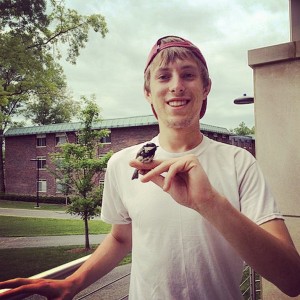For the second consecutive summer, Kara Loeb Belinsky, assistant professor of biology at SUNY New Paltz, is working with students to track bird populations and behavior patterns on campus, offering opportunities to conduct hands-on research and collect data that could help boost biodiversity at the College.
The study takes advantage of the campus’s ability to function as a “living laboratory,” as its diverse plant and animal ecology lets students and faculty plan and execute long-term research programs right outside the classroom window.
 She began in 2014 with the installation of a network of nine bird feeders. These allow Belinsky and her students to record information about the diversity and abundance of bird species in different types of areas on campus.
She began in 2014 with the installation of a network of nine bird feeders. These allow Belinsky and her students to record information about the diversity and abundance of bird species in different types of areas on campus.
“The study of animals in human-dominated landscapes is a new and important focus of behavioral and ecological biology as our planet becomes increasingly urbanized and human population continues to grow,” Belinsky said. “I wanted to know if the relatively small-scale urbanization that is our campus and our village is affecting biodiversity in similar ways that larger-scale urbanization does in cities.”
The early findings indicate that urbanized areas on campus are indeed dominated by invasive species that are comfortable with human proximity, like the small brown house sparrow that will be familiar to many community members. These areas are less likely to be populated by species native to the area, such as the American goldfinch, the black-capped chickadee and the dark-eyed junco, all of which can be found in more secluded and forested areas on campus.
This summer the researchers have focused more on observing the behavior of individual birds, which will bring them closer to their ultimate goal of deepening the College community’s understanding of the local ecosystem and developing recommendations to improve the health of campus habitats.
“We see this as the beginning of a study that will grow,” Belinsky said. “The resources available on campus will enable us to continue to add new components, such as new bird feeders and nesting boxes.”
Belinsky, who is credentialed as a U.S. Geological Survey Master Bander, is leading and carefully instructing a small group of student assistants as they undertake to safely and humanely catch birds at feeders, place small identifying bands around their legs and release them back into the wild for future observation.
“Being involved in field work allows me to apply what I have learned in class, which makes me feel like I have a strengthened understanding of the subject matter,” said Matt Richards ’15 (Biology), who has been working with Belinsky this summer. “I enjoy working with birds, and this experience has helped me to realize that there are many different opportunities to work in this field. And being able to do this research here on campus just adds to the convenience.”
This research is made possible in part by the Sustainability Seed Fund, which launched in April 2015 to support students, faculty and staff in work that advances campus sustainability initiatives.

